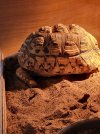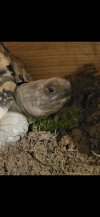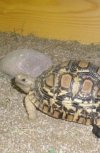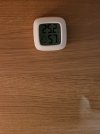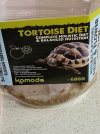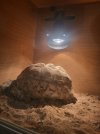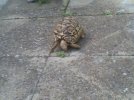spursuk
New Member
Hi everyone new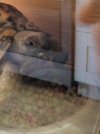 here. I have a tortoise (roughly 21 F) not totally certain on breed as she was a gift. We believe she's a leapord although someone on here may be able to tell... For the last few months she's had this yellow/white thing on the side of her mouth under her beak. It now appears to be on both sides. After googling I feared mouth rot however its not discharge and it's not inside her mouth. Apparently they lose their appetite with mouth rot aswell because it hurts to eat but my tortoise is eating and acting normally, has a big appetite and feels heavy. It doesn't help that the nearest exotic vet to us is a long way away. I did buy some tamodine and was using that thinking it might be a wound but I have no idea if it's helped
here. I have a tortoise (roughly 21 F) not totally certain on breed as she was a gift. We believe she's a leapord although someone on here may be able to tell... For the last few months she's had this yellow/white thing on the side of her mouth under her beak. It now appears to be on both sides. After googling I feared mouth rot however its not discharge and it's not inside her mouth. Apparently they lose their appetite with mouth rot aswell because it hurts to eat but my tortoise is eating and acting normally, has a big appetite and feels heavy. It doesn't help that the nearest exotic vet to us is a long way away. I did buy some tamodine and was using that thinking it might be a wound but I have no idea if it's helped
 here. I have a tortoise (roughly 21 F) not totally certain on breed as she was a gift. We believe she's a leapord although someone on here may be able to tell... For the last few months she's had this yellow/white thing on the side of her mouth under her beak. It now appears to be on both sides. After googling I feared mouth rot however its not discharge and it's not inside her mouth. Apparently they lose their appetite with mouth rot aswell because it hurts to eat but my tortoise is eating and acting normally, has a big appetite and feels heavy. It doesn't help that the nearest exotic vet to us is a long way away. I did buy some tamodine and was using that thinking it might be a wound but I have no idea if it's helped
here. I have a tortoise (roughly 21 F) not totally certain on breed as she was a gift. We believe she's a leapord although someone on here may be able to tell... For the last few months she's had this yellow/white thing on the side of her mouth under her beak. It now appears to be on both sides. After googling I feared mouth rot however its not discharge and it's not inside her mouth. Apparently they lose their appetite with mouth rot aswell because it hurts to eat but my tortoise is eating and acting normally, has a big appetite and feels heavy. It doesn't help that the nearest exotic vet to us is a long way away. I did buy some tamodine and was using that thinking it might be a wound but I have no idea if it's helped